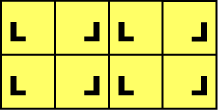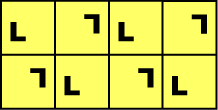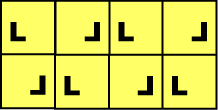|
TESSELLATIONS
You are sure to have some idea as to what a tessellation is. (Be careful with the spelling: two s s and two l s!)
|
|
|
|
|
As previously, we are free to define a tessellation in any way we like, but it is best if our definition is useful, and also recognized by others. A general definition might be: A tessellation is a repeated geometric design that covers a plane without gaps or overlaps. This certainly conveys the general idea. However, we might decide to exclude the infinite stripes, above left. In other words, it is useful to use bounded geometric designs to tile the plane. Notice that we have no problem tessellating with an elaborate shape such as the turtle above. The square pattern at right raises other concerns for us, especially as we will be concentrating on polygonal tessellations. Do we wish to allow similar components in our tessellation? – in this example, squares of different sizes. And related to this, would we like our polygons only to have edges and vertices in common? – unlike this situation You can have a lot of fun with general tessellations. They are quite hard to construct, as each boundary point has to also be a boundary point of an adjacent figure. You might like to check out Bruce Bilney’s fun Australian pages, or many other fascinating tessellation sites. Maurits Escher was a master at constructing tessellations. |
|
|
One obvious place where tessellations occur is in wallpaper designs. Of course there are a great number of such designs, but many of them have the same underlying structural pattern. Perhaps there are a finite number of such patterns? Consider the following situation.
There are in fact exactly 17 wallpaper groups. As some of them involve rotations of 60° or 120°, they cannot all be obtained by the above method. The groups have rather weird symbolic names like p1, pm, pg, cm arising from crystallography, and indicating the types of isometry contained – if you can break the code! Personally, I have always found identifying wallpaper groups requires painstaking care. An excellent outline of this topic can be found in Wikipedia. |
|
|
What is a tessellation? Bruce Bilney : Ozzigami : http://www.ozzigami.com.au/ Maurits Escher site: http://www.mcescher.com/ Making your own tessellations : http://mathcentral.uregina.ca/RR/database/RR.09.96/archamb1.html Classifying tessellations Wikipedia : http://en.wikipedia.org/wiki/Wallpaper_group#Group_p1 |
|
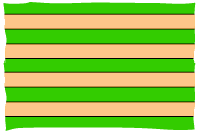
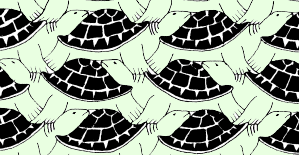
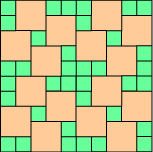
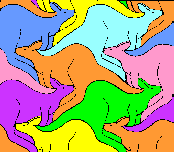 where each large square has a half-edge in common with each adjacent square.
where each large square has a half-edge in common with each adjacent square. 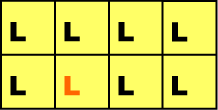 This pattern of 1 x 1 squares clearly tessellates the plane. Can we describe this tessellation? Starting with the square with the orange L, every other square can be obtained by repeatedly applying two translations: a horizontal translation T through distance 1, and a vertical translation U through distance 1. For example the square to the right above the initial square is obtained by TU (T followed by U) or UT. The square to the left of the initial square is obtained by the inverse translation T –1 – a horizontal translation through –1. In fact, each square can be
This pattern of 1 x 1 squares clearly tessellates the plane. Can we describe this tessellation? Starting with the square with the orange L, every other square can be obtained by repeatedly applying two translations: a horizontal translation T through distance 1, and a vertical translation U through distance 1. For example the square to the right above the initial square is obtained by TU (T followed by U) or UT. The square to the left of the initial square is obtained by the inverse translation T –1 – a horizontal translation through –1. In fact, each square can be 